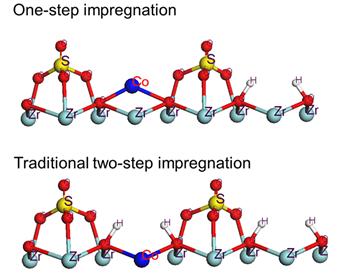| One-step impregnation: a new method for introducing Co2+ into ZrO2 with little change of the Br?nsted acid sites |
| From: PublishDate:2012-06-26 Hits: |
Sulphated metal oxides with both Brönsted and Lewis acid sites are widely used as solid acid catalysts and/or supports in organic synthesis, transformation reactions, and NOx removal. Of particular interest is sulphated zirconia (the first impregnation), which possesses more acid sites than other sulphated metal oxides. To further improve the properties of sulphated zirconia, active component transition metal cations have been introduced into sulphated zirconia by impregnation (the second impregnation). However, this conventional two-step impregnation method often decreases the number of Brönsted acid sites, since these sites are preferentially occupied by the cations introduced, such as Co and Pd. As Brönsted acid sites play a crucial role in both the anchoring other active components and in catalytic reactions, such a decrease would cause deteriorations the intrinsic properties of solid acid materials. Thus, designing and implementing new methods for the introduction of transition metals into sulphated zirconia while minimizing the consumption of Brönsted acid sites is of particular importance. A team from Environmental Catalysis and Heterogeneous Atmospheric Chemistry of Research Center for Eco-Environmental Sciences developed a one-step impregnation method, by which the transition metal Co2+ cations were successfully introduced into zirconia with little consumption of Brönsted acid sites. Their research has been published on April 25th, 2011 in Journal of Catalysis. The sulphation of Zr-Co hydroxides was employed to introduce Co species and to increase the number of acid sites. The number of Brönsted acid sites on sulphated Zr-Co oxide prepared by this method was much larger than that on zirconia prepared by the two-step impregnation method. As a result, sufficient Brönsted acid sites are left available for the introduction of a second active component and subsequent catalytic reactions. Specifically, a sulphated Zr-Co hydroxides supported Pd catalyst is further prepared by the impregnation method. As expected, this catalyst showed high activity towards the selective catalytic reduction of NOx with methane. Using X-ray Absorption Spectroscopy (Zr and Co K-edge), they provide the direct evidence of the entrance of Co into the lattice of cubic zirconia to form a substitutional solid solution. As a new and simple approach, the one-step impregnation method provides significant advantages for the design of catalysts that require Brönsted acid sites and for further introduction of other active components. Fig.1 Possible structure of Co introduced zirconia with different methods
Article: Xiangjie Wang, Huayu Wang, Yongchun Liu, Fudong Liu, Yunbo Yu*, Hong He*, A direct sulphation method for introducing transition metal cation Co2+ into ZrO2 with little change of the Brönsted acid sites, Journal of Catalysis, 2011,279,301–309. |
|
|
| Chinese
Science Highlights
Home /
Copyright © 2011 - 2012 Beijing Synchrotron Radiation Facility


